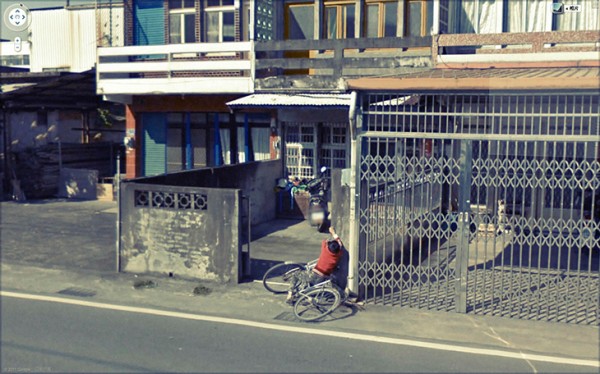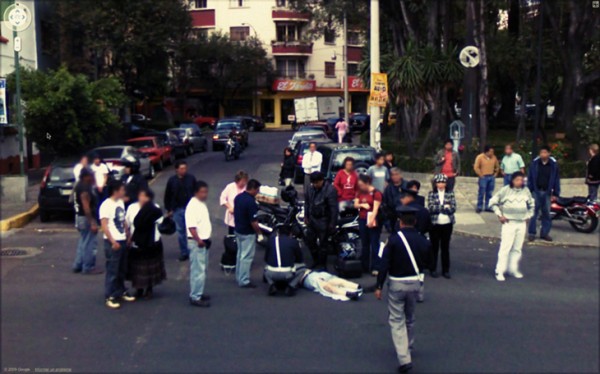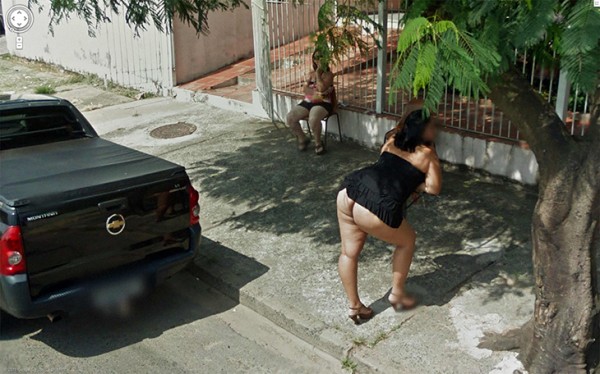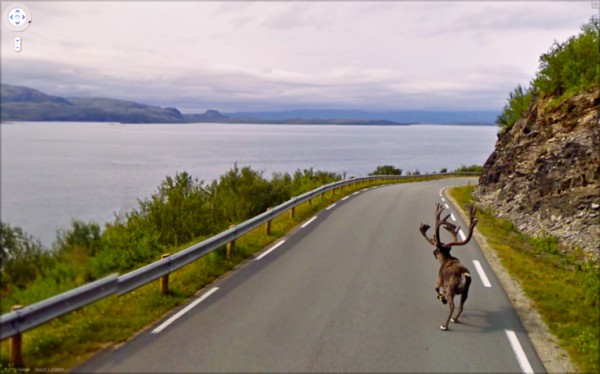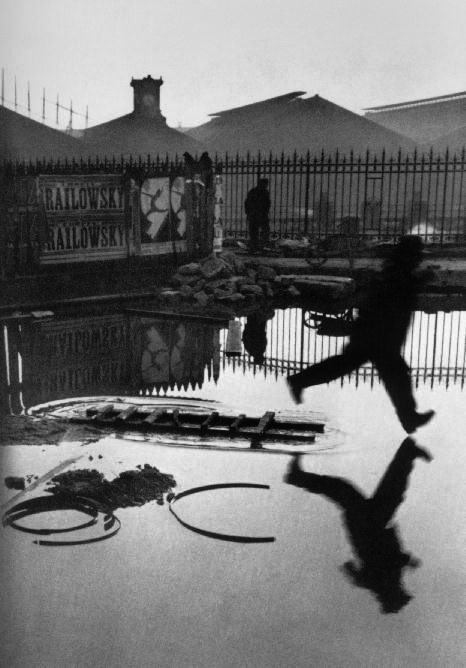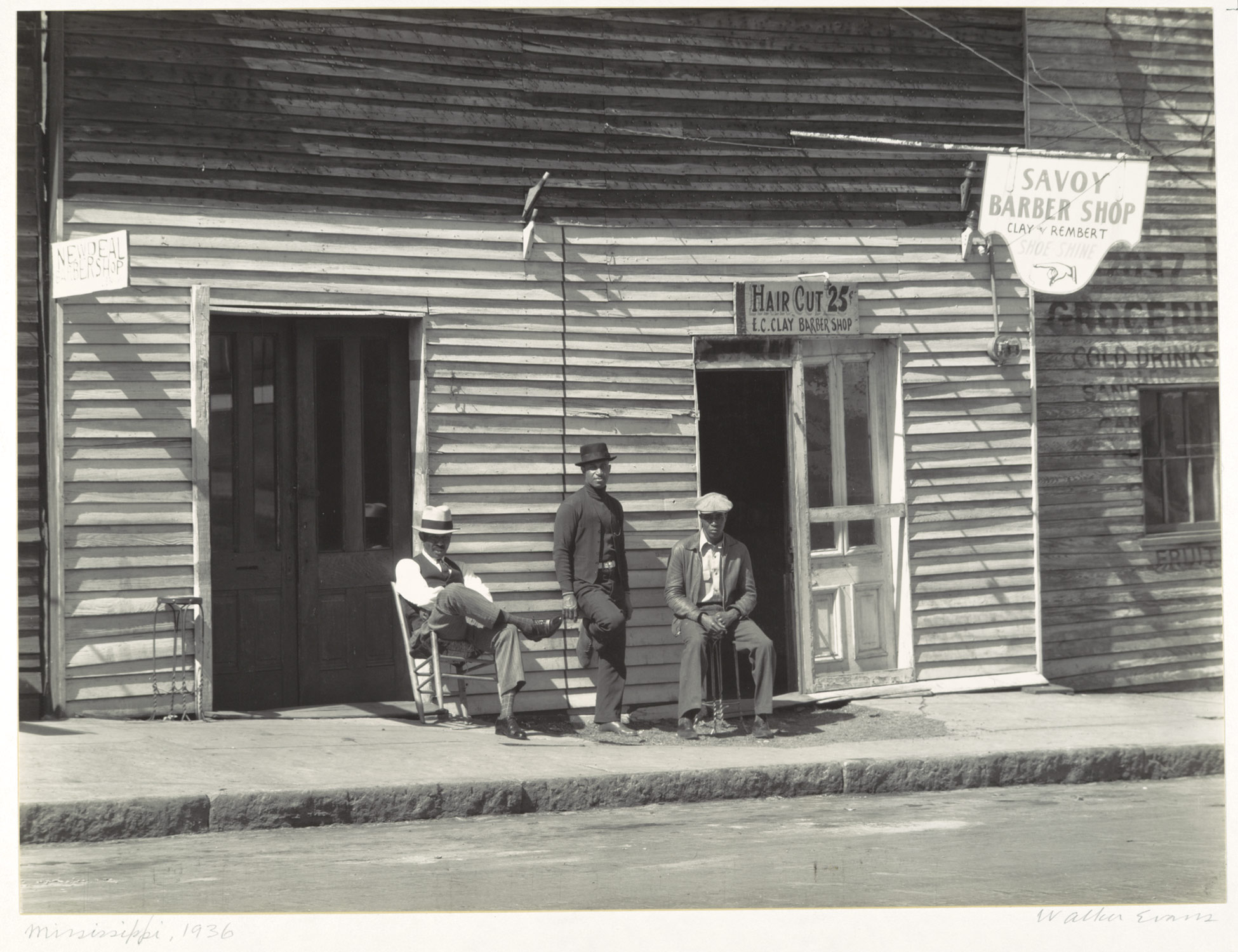Sunday, 28 April 2013
Martin Parr - Documentary or Street photographer?
'Street photography is a genre of photography that features subjects in candid situations within public places.'
'Documentary photography usually refers to a popular form of photography used to chronicle significant and historical events. It is typically covered in professional photojournalism, or real life reportage, but it may also be an amateur artistic, or academic pursuit. The photographer attempts to produce truthful, objective, and usually candid photography of a particular subject, most often pictures of people.'
I have always known Martin Parr to be a documentary photographer, but after looking at his images I feel that his work can be seen to be taken by a street photographer. When looking for a description for both documentary and street photography, both are seen to be candid situations producing truthful imagery.
Whilst looking at the photographers that use Google street view I have found that Doug Rickard and Mishka Henner both border on social documentary and street photography. They are documenting significant events in the 21st century, they are truthful, real life reportage of what is happening in poverty struck areas.
When researching 'What is street photography' I came across this link:
http://www.lfph.org/what-is-street-photography
It lists within the site different street photographers, one that is mentioned is Martin Parr.
Martin Parr is known for his photographic projects that take a critical look at aspects of modern life, but his images can be seen as candid imagery; capturing moments that are quite bizarre and funny.
THE LAST RESORT
http://www.rosegallery.net/data/photos/5714_1parr_gulls_fries.jpg
http://blog.zeit.de/fotoblog/files/2010/01/parr-last-resort-2-940.jpg
http://iconicphotos.files.wordpress.com/2012/02/6368885539_2963bf8751_b.jpg?w=700&h=559
http://www.rrr.org.au/assets/martin_parr_the_last_resort_1145_67.jpg
Parr can be seen to poke fun at working call holiday makers, from the images he has taken at Brighton beach. "The principle objection would be that I would appear to be cynical, voyeuristic, exploitative." http://www.bbc.co.uk/photography/genius/gallery/parr.shtml
Although that may be true, and he may be documenting a critical view of modern day life, I still feel this is more like street photography. It is capturing real moments of holiday makers, which you would of found in the late 80's walking around the street of any northern beach resort. I feel that the images relate more to street photography, they are truthful truthful and blunt; but the use of these images make them into documentary photography.
Parr's images remind me of the work Maciej Dakowicz, who got his influence from Parr. His photography piece 'Cardiff after dark' documents Cardiff's nightlife, which he five year producing. Dakowicz can also be seen poking fun at the nightlife in Cardiff and what happens, but it also captures real moments that are open for the viewer's opinions.
http://payload26.cargocollective.com/1/3/110769/2827483/d5IMG3_2296-cs4_680.jpg
http://i.telegraph.co.uk/multimedia/archive/02007/cardiff-chips_2007145i.jpg
In my opinion on both Parr and Dakowicz image's is that they capture real moments in time, but the photographers account behind the images make us believe they are poking fun out of the subject in the images. They are both documenting and taking a critical look at aspects of working class lives, but the pictures are a clear indication of street photography. Personally for me, it highlights the hilarous accounts of real behaviour, in both Parr's and Dakowicz's work.
Parr's images at Brighton beach remind me of my childhood and how I spent my summer holidays at the beach, and although I find them to be mocking working class; I still find them quite humorous and a factor of daily life in the late 80's early 90's.
Jon Rafman
'Street photography is a genre of photography that features subjects in candid situations within public places.'
This description of street photography is a perfect example of Jon Rafman's work. Rafman's photography piece 'The Nine Eye of Google street view' are images that he has found unusual, bizarre, weird occurrences that you wouldn't normally see, via Google street view.
Jon Rafman’s work consists of collecting moments the camera ‘coincidentally’ or ‘accidentally’ captures out of ordinary. A child falling of its bicycle in Taiwan or a car crash with a fatality lying on the road in Mexico. Rafman doesn't just capture images that are alarming, he also captures the beauty on the earth such as a butterfly that flies in the perfect centre of the image and an elk running in front of (or being chased by) Google’s car in Norway. http://visualcultureblog.com/2012/09/the-nine-eyes-of-google-street-view/
http://visualcultureblog.com/wp-content/uploads/2012/09/20120703011857_No.752Xia2011-e1348493372916.jpeg
http://visualcultureblog.com/wp-content/uploads/2012/09/20120703125145_Eje3SurAv.BajaCaliforniaAltataD.f.Mexico2009-e1348494110891.jpeg
http://visualcultureblog.com/wp-content/uploads/2012/09/20120703114633_139RuaIndCampinasSPauloBrazil2012-e1348493301260.jpeg
http://visualcultureblog.com/wp-content/uploads/2012/09/20120703115000_253RuaLisboaItapecericadaSerraPauloBrasil2010.jpeg
http://visualcultureblog.com/wp-content/uploads/2012/09/20120528035639_jon_rafman_Rv888_Finnmark_Norway_2010-e1348493582321.jpeg
http://www.stylecrave.de/bilder/personen/jon-rafman-9-eyes-google-street-view-2.JPG
http://www.livingdesign.info/wp-content/uploads/2012/08/Nine-Eyes-Jon-Rafman-02.jpg
One of the reasons why I am so fascinated in Rafman's images is dues to the candidness of the images, some of them are so surreal yet seem to happen daily. The first and last image I have shown above are two images that feel so normal that it make you laugh just a little; the moments where you are grateful no one saw, yet they were caught on Google maps. A typically ironic moment.
I think Rafman has made this piece in a none judgmental way, by picking out many images that are vastly different from one another. Some are shocking, yet some are comically humorous, and this makes me want to look at his images all day. The 6th image shown above just shows the surrealism and comic humour I am talking about; the fact that you wouldn't think of coming across this in daily life yet it did happen. You start to question the moments before this snapshot happened, and the moments afterwards when the car drove passed.
The images he has chosen seem to capture what you wouldn't necessarily think would be captured by Google street view and you begin to think the hours that Rafman put into to find these shots (12 hours a day). http://www.ibtimes.co.uk/articles/366992/20120726/nine-eyes-google-street-view-jon-rafman.htm
Rafman's found images are very similar to the work of Henri Cartier-Bresson and Garry Winogrand.
Gary Winogrand work was influenced my Robert Frank and Walker Evans, who also influenced the work of Doug Rickard. Although Rickard and Rafmans work are different in many ways, they seem to of gotten ideas from the same photography background. Winogrand was a street photographer known for his portrayal of America in the mid-20th century. An image that strikes me when connected him to Rafman's work is the image shown below.
http://www.masters-of-photography.com/images/screen/winogrand/winogrand_flip.jpg
The image above also links with one of Henri Cartier-Bresson's images shown below:
http://erickimphotography.com/blog/wp-content/uploads/2011/08/henri-cartier-bresson-gare.jpg
Henri Cartier-Bresson was a French photographer considered to be the father of modern photojournalism, and the master of candid photography.
Both Bresson's and Winogrand's images capture something in just the right moment, which is very similar to what Rafman tries to show in his images.
This description of street photography is a perfect example of Jon Rafman's work. Rafman's photography piece 'The Nine Eye of Google street view' are images that he has found unusual, bizarre, weird occurrences that you wouldn't normally see, via Google street view.
Jon Rafman’s work consists of collecting moments the camera ‘coincidentally’ or ‘accidentally’ captures out of ordinary. A child falling of its bicycle in Taiwan or a car crash with a fatality lying on the road in Mexico. Rafman doesn't just capture images that are alarming, he also captures the beauty on the earth such as a butterfly that flies in the perfect centre of the image and an elk running in front of (or being chased by) Google’s car in Norway. http://visualcultureblog.com/2012/09/the-nine-eyes-of-google-street-view/
http://visualcultureblog.com/wp-content/uploads/2012/09/20120703011857_No.752Xia2011-e1348493372916.jpeg
http://visualcultureblog.com/wp-content/uploads/2012/09/20120703125145_Eje3SurAv.BajaCaliforniaAltataD.f.Mexico2009-e1348494110891.jpeg
http://visualcultureblog.com/wp-content/uploads/2012/09/20120703114633_139RuaIndCampinasSPauloBrazil2012-e1348493301260.jpeg
http://visualcultureblog.com/wp-content/uploads/2012/09/20120703115000_253RuaLisboaItapecericadaSerraPauloBrasil2010.jpeg
http://visualcultureblog.com/wp-content/uploads/2012/09/20120528035639_jon_rafman_Rv888_Finnmark_Norway_2010-e1348493582321.jpeg
http://www.stylecrave.de/bilder/personen/jon-rafman-9-eyes-google-street-view-2.JPG
http://www.livingdesign.info/wp-content/uploads/2012/08/Nine-Eyes-Jon-Rafman-02.jpg
One of the reasons why I am so fascinated in Rafman's images is dues to the candidness of the images, some of them are so surreal yet seem to happen daily. The first and last image I have shown above are two images that feel so normal that it make you laugh just a little; the moments where you are grateful no one saw, yet they were caught on Google maps. A typically ironic moment.
I think Rafman has made this piece in a none judgmental way, by picking out many images that are vastly different from one another. Some are shocking, yet some are comically humorous, and this makes me want to look at his images all day. The 6th image shown above just shows the surrealism and comic humour I am talking about; the fact that you wouldn't think of coming across this in daily life yet it did happen. You start to question the moments before this snapshot happened, and the moments afterwards when the car drove passed.
The images he has chosen seem to capture what you wouldn't necessarily think would be captured by Google street view and you begin to think the hours that Rafman put into to find these shots (12 hours a day). http://www.ibtimes.co.uk/articles/366992/20120726/nine-eyes-google-street-view-jon-rafman.htm
Rafman's found images are very similar to the work of Henri Cartier-Bresson and Garry Winogrand.
Gary Winogrand work was influenced my Robert Frank and Walker Evans, who also influenced the work of Doug Rickard. Although Rickard and Rafmans work are different in many ways, they seem to of gotten ideas from the same photography background. Winogrand was a street photographer known for his portrayal of America in the mid-20th century. An image that strikes me when connected him to Rafman's work is the image shown below.
http://www.masters-of-photography.com/images/screen/winogrand/winogrand_flip.jpg
The image above also links with one of Henri Cartier-Bresson's images shown below:
http://erickimphotography.com/blog/wp-content/uploads/2011/08/henri-cartier-bresson-gare.jpg
Henri Cartier-Bresson was a French photographer considered to be the father of modern photojournalism, and the master of candid photography.
Both Bresson's and Winogrand's images capture something in just the right moment, which is very similar to what Rafman tries to show in his images.
Mishka Henner
Another example of a street photographer (who could also be seen as a Social documentary photographer) is Mishka Henner. The piece of work I have been looking at is called 'No mans land' which captures, from Google street view, what appears to be women soliciting sex on the outskirts of European cities. From the article on designboom, is says that Henner found the locations of the google street coordinates from sources off online forums, where men share local knowledge on the whereabouts of sex workers.
http://www.designboom.com/art/mishka-henner-no-mans-land/
http://www.ideastap.com/Upload/CmsMedia/magazine/Articles/mishka-henner3.jpg
http://www.designboom.com/weblog/images/images_2/erica/847/no02.jpg
http://www.hotshoegallery.com/wp-content/uploads/2011/05/mh1.jpg
The images that he has created are all very similar to each other, in the sense of surrealism and isolation. Like Rickard's work, he is focusing on something very real and problematic. In many of Henner's images the roads are empty, making the viewer uneasy whilst seeing almost fragile women standing on the side of the road waiting for someone to drive past. The isolation of where they are standing/sitting, with the lack of clothes they are wearing makes me feel, as a viewer, unsafe. The surrealism of it all daunts the fact that it is very much occurring, the women casually sitting in chairs on the side of the roads is quite alarming and sinister.
http://www.designboom.com/art/mishka-henner-no-mans-land/
http://www.ideastap.com/Upload/CmsMedia/magazine/Articles/mishka-henner3.jpg
http://www.designboom.com/weblog/images/images_2/erica/847/no02.jpg
http://www.hotshoegallery.com/wp-content/uploads/2011/05/mh1.jpg
The images that he has created are all very similar to each other, in the sense of surrealism and isolation. Like Rickard's work, he is focusing on something very real and problematic. In many of Henner's images the roads are empty, making the viewer uneasy whilst seeing almost fragile women standing on the side of the road waiting for someone to drive past. The isolation of where they are standing/sitting, with the lack of clothes they are wearing makes me feel, as a viewer, unsafe. The surrealism of it all daunts the fact that it is very much occurring, the women casually sitting in chairs on the side of the roads is quite alarming and sinister.
Doug Rickard
Doug Rickard uses Google street view to make people take a closer look at the poverty struck areas that are still around in America. Rickard searches through the streets through the eyes of Google's street view camera, and takes a pictures of the already made snapshot. He places is camera facing the computer screen and carefully re-photographs the image that is on his screen.
'The
pictures that I chose don’t really have a strong feeling of spying; the
pixilation and the broken elements actually emphasize the subtext and the
emotion that I wanted to impart, which was America in a devastated form, almost
the inverse of the American dream. The aesthetic that I used heightens that
sense'. this a quote from Rickard of which Time Lightbox used in their article:- Street View and Beyond: Google’s Influence on Photography. http://lightbox.time.com/2012/10/24/street-view-and-beyond-googles-influence-on-photography/#1
When looking at his images I look back and this quote and feel it makes a lot of sense. The use of pixilation and broken elements, as Rickard says, really emphasises the concept of his work. He is looking at run down, poverty struck neighbourhoods, and I feel that the use of pixilation adds to the devastating areas you see via these images. It makes they images look more like the area itself, a worn, decaying feeling; a feeling of brokenness by poverty.
His images are very similar to the work of Walker Evans and Robert Frank; who both documented the poor, and division of race and class. The images are very much real life, a documentary of how things were in the time of when the image was taken. Frank was very much influenced by Evans and Rickard has shown relavance in his own work that he has been influenced by both of these photographers.
http://www.metmuseum.org/toah/images/hb/hb_1999.237.1.jpg
http://iconicphotos.files.wordpress.com/2012/02/robert-frank_trolley-new-orleans_1955.jpg?w=700&h=455

Walker Evans
Robert Frank
http://www.metmuseum.org/toah/images/hb/hb_1999.237.1.jpg
http://iconicphotos.files.wordpress.com/2012/02/robert-frank_trolley-new-orleans_1955.jpg?w=700&h=455
Walker Evans
Robert Frank
https://www.youtube.com/watch?v=fwLHc4vCcdQ
This video shows Doug Rickard explaining what his work is all about and how he achieves it. To find the streets that he need he uses Martin Luther King's name find these derelict areas.
'MLK is just a massive symbol of hope, and I'm using him to locate where there is little hope' Rickard says in the video. I think the concept of using a symbol of hope to find those who have none is a very smart idea, it almost contradicts everything that Martin Luther King stood for and pulls out the major issue that things have not changed.
The reason for looking further into the poverty stricken America is due to Rickard background. On the video he says that his father very much idealised America, but whilst studying civil right and slavery he was very much affected an American story that was very much different to how he had seen his country.
http://www.newyorker.com/online/blogs/newsdesk/%2382.948842,%20Detroit,%20MI%20(2009),%202010%20(large).jpg
,%202010%20(large).jpg)
http://www.blackflash.ca/wp-content/uploads/2011/10/Picture-21.png
I feel his images bring out a very derelict, almost isolated feeling. The streets feel very empty, even when there is presence of people in the photograph. As a viewer you are very much emotionally connected to the space that is shown, a feeling of isolation consumes you and me as a viewer feel very anxious. Although this is normal living environments for these people, you sense the isolation from the world around; is feels very closed and separate from other American areas that are more wealthy. The image at the bottom shows this isolation a lot more clearly; as a boy cycles past boarded up housing as though it is very normal for him. I feel the fact that this is very much real life, makes us as a viewer feel horrified that people can still live in the state of poverty.
What really strikes me about Rickard's work is his method to find these area's. By using Martin Luther King's name, a symbol of hope for Black Americans, he was able to find the most poverty stricken areas of America. 'I have a dream that one day this nation will rise up and live out the true meaning of its creed: "We hold these truths to be self-evident: that all men are created equal."' is part of King's speech he made in 1963. I feel that the dreams that he has is very much evident in these images that it has not happened.
Rickard's work is described as social documentary photographer, although his work consists of street work. I feel, for many photographers I have looked at there is a cross over between whether they are documentary photographers or street photographers. I will look into this more through my blog.
Saturday, 6 April 2013
Essay choice
At the start of this blog I started of looking at two essay title choices:
‘Within Western culture, the body which is visible to the public gaze is young, beautiful and healthy’.
‘Within Western culture, the body which is visible to the public gaze is young, beautiful and healthy’.
Consider
this statement more fully and relate it to the work of one or two recent
photographers who attempt to ‘challenge’ such stereotypes.
and also
Compare and contrast the street photography work of any two
photographers working in the period 1960 –now
Although I was interested in learning about Jo Spence and Rosy Martin, (lecture 14th Feb), I feel that the second essay title would be best for me. As you can see in the other blogs I have been able to find quite a lot of information about a number of photographers; and this is just at the start.
Both Spence and Martin question how we do not see the aging, the ill, people who are not thin; in the media. Martin targets this particularly well in her Outrageous Agers.
"Ignoring the implicit notice 'no woman over 30 need enter' we re-visited Top Shop to engage with and perform the stereotype of 'mutton dressed as lamb' by trying on a range of trendy clubwear, lycra-stretched sequins, leopard-skin print and PVC. Squeezed into the frame, our bodies mirror the desire and discontent of the loss of the anyway already impossible 'perfect' body. Trying on youth in a changing room, the flesh of the body reasserts itself through the stretched fabric, it cannot be contained or forced to fit within fashions parameters."
This reminds me of myself trying clothes on in a clothes store, I always think to myself 'I wonder if they have considered the fact that most people aren't catwalk models'. The line "Squeezed into the frame, our bodies mirror the desire and discontent of the loss of the anyway already impossible 'perfect' body" makes me wonder whether our view on 'perfect' body comes from the images of models and if people making the clothes view society having small slender bodies. We see nowadays, in magazines, images of celebrities that have put on a extra few pounds and it is seen to be a negative thing. Martin is tackling the high street clothing stores, showing how even in the high street we a faced with clothing made for younger, thinner people with the 'perfect' body; but what about the others?
Although naturally interested in this topic, I have found myself interested in Street photography and how photographers use Google street view for their photography pieces.
Although naturally interested in this topic, I have found myself interested in Street photography and how photographers use Google street view for their photography pieces.
'A New American Picture' shows the forgotten areas of America struggling to cope in the new financial circumstances; and I feel how he has used Google maps to show this is a genius idea.
I want to chose the second essay title, as I feel comparing a photographer that uses Google street view with a photographer who goes out on the streets, with a camera, would be a highly interesting topic to pursue.
Subscribe to:
Posts (Atom)





